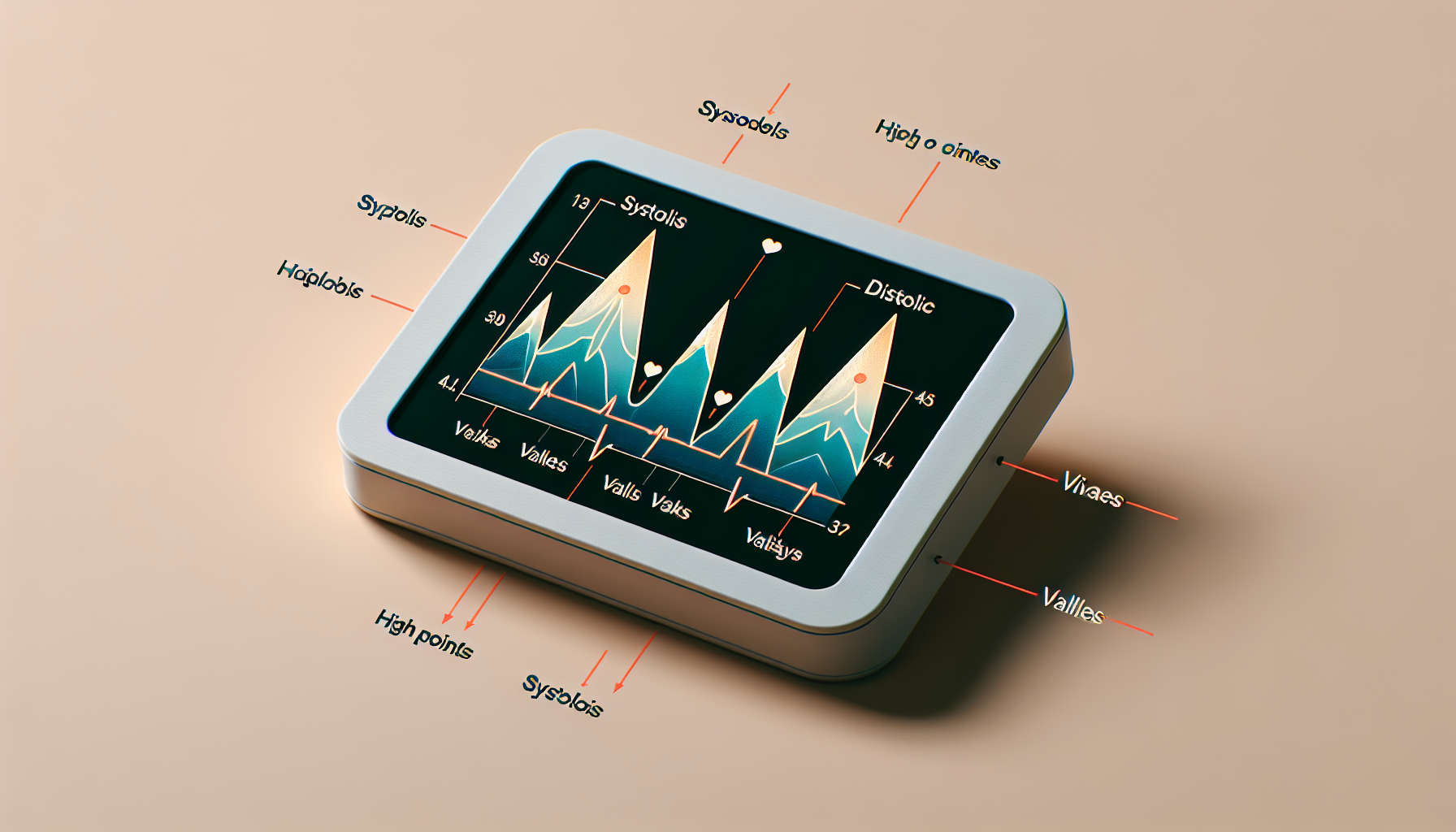In the world of health and wellness, there are numerous terms thrown around that can sometimes be a bit confusing. One such pair of terms is systolic and diastolic blood pressure. You may have heard these words mentioned during your doctor visits, but what exactly do they mean? Systolic blood pressure refers to the pressure in your arteries when your heart contracts and pumps blood. On the other hand, diastolic blood pressure is the pressure in your arteries when your heart is at rest between beats. Understanding the difference between these two numbers can provide valuable insight into your overall cardiovascular health. Researchers have conducted several studies exploring the relationship between systolic and diastolic blood pressure and how they relate to various health conditions. For example, a recent study published in the British Medical Journal found that a higher systolic blood pressure was associated with an increased risk of cardiovascular disease. Another study from the Journal of Hypertension discovered that a greater difference between systolic and diastolic blood pressure could indicate the presence of arterial stiffness. So, the next time you get your blood pressure checked, remember the importance of both systolic and diastolic measurements in evaluating your cardiovascular health.
Discover the Ultimate Weight Loss Secrets Here!
Understanding Blood Pressure
Blood pressure is a crucial indicator of your overall health. It measures the force exerted by your blood against the walls of your arteries as your heart pumps it around your body. This force is essential, as it ensures that your organs and tissues receive the oxygen and nutrients they need to function properly.
Blood pressure is expressed as a ratio of two numbers: systolic and diastolic. These numbers represent the pressure in your arteries during two different phases of your heartbeat.
Systolic Blood Pressure
Definition and Measurement
Systolic blood pressure is the top number in the blood pressure reading, and it represents the pressure exerted on the arterial walls when your heart contracts and pumps blood. It is measured in millimeters of mercury (mmHg) and is always higher than the diastolic pressure.
When your doctor or nurse takes your blood pressure using a sphygmomanometer, they listen for the first sound (Korotkoff sound) as blood starts flowing through the partially closed artery. This sound indicates the systolic pressure.
Impact on Health
Systolic blood pressure plays a critical role in determining your risk for cardiovascular diseases such as heart attacks and strokes. As the heart pumps blood out into the arteries, the force exerted can strain the arterial walls, causing damage over time. High systolic blood pressure can lead to conditions like hypertension, which puts additional stress on the heart and can lead to serious health complications if left untreated.
Click Here for Proven Fat-Burning Strategies!
Diastolic Blood Pressure
Definition and Measurement
Diastolic blood pressure is the bottom number in the blood pressure reading and represents the pressure in the arteries when the heart is at rest between beats. It is also measured in mmHg and is always lower than the systolic pressure.
The diastolic pressure is determined by listening for the sound when the blood flow becomes smooth and uninterrupted, indicating that the artery is fully open.
Importance for Health
While systolic blood pressure often receives more attention, diastolic blood pressure is equally important. It reflects the resistance in the peripheral arteries and the overall health of the cardiovascular system. High diastolic blood pressure can indicate increased arterial stiffness or narrowed blood vessels, which can impair blood flow to vital organs and increase the workload on the heart.
The Relationship Between Systolic and Diastolic Blood Pressure
Normal Blood Pressure Range
A healthy blood pressure reading is typically around 120/80 mmHg. The systolic pressure of 120 represents the peak pressure when the heart contracts, while the diastolic pressure of 80 represents the pressure when the heart is at rest.
Hypertension and Hypotension
Hypertension refers to persistently high blood pressure, with systolic readings above 130 mmHg and/or diastolic readings above 80 mmHg. Hypotension, on the other hand, is characterized by low blood pressure, often below 90/60 mmHg.
Both hypertension and hypotension can have serious health implications. Hypertension increases the risk of heart disease, stroke, and other cardiovascular conditions, while hypotension can cause dizziness, fainting, and inadequate blood flow to the organs.

Causes of High or Low Systolic Blood Pressure
Age and Gender
As you age, your blood vessels lose elasticity, leading to higher systolic blood pressure. Gender also plays a role, as men tend to have higher systolic blood pressure than premenopausal women.
Lifestyle Factors
Unhealthy habits, such as a sedentary lifestyle, poor diet, excessive salt intake, and smoking, can contribute to high systolic blood pressure. Regular exercise, a balanced diet, and stress reduction techniques can help manage systolic blood pressure.
Underlying Medical Conditions
Certain medical conditions like kidney disease, hormonal disorders, and sleep apnea can cause high systolic blood pressure. It is important to address these underlying conditions to effectively manage blood pressure.
Causes of High or Low Diastolic Blood Pressure
Age and Gender
Similar to systolic blood pressure, age and gender also influence diastolic blood pressure. Older individuals and men tend to have higher diastolic pressure.
Lifestyle Factors
Unhealthy lifestyle choices, including a high-sodium diet, excessive alcohol consumption, and chronic stress, can contribute to high diastolic blood pressure. Incorporating healthier habits can help lower diastolic pressure.
Underlying Medical Conditions
Medical conditions such as diabetes, kidney disease, and thyroid disorders can lead to high diastolic blood pressure. Identifying and treating these conditions is crucial for managing blood pressure effectively.

Risk Factors and Health Implications
Cardiovascular Diseases
Both high systolic and diastolic blood pressure increase the risk of developing cardiovascular diseases. Over time, the increased pressure can damage the arteries, leading to atherosclerosis, heart attacks, or strokes.
Organ Damage
When blood pressure remains consistently high, it can damage various organs in the body, including the heart, kidneys, brain, and eyes. This damage can impair their proper functioning and lead to serious health complications.
Stroke and Heart Attack
High blood pressure is a significant risk factor for strokes and heart attacks. The increased pressure weakens the blood vessel walls, making them more susceptible to rupture or clot formation, which can block blood flow and cause a stroke or heart attack.
Measuring Blood Pressure
Sphygmomanometer
A sphygmomanometer is the traditional device used to measure blood pressure. It consists of an inflatable cuff, a pressure gauge, and a stethoscope. The cuff is wrapped around the upper arm, inflated to momentarily stop blood flow, and then gradually deflated while listening for the Korotkoff sounds.
Home Blood Pressure Monitoring
Home blood pressure monitoring allows individuals to measure their blood pressure on their own using electronic blood pressure monitors. This method provides a convenient way to track blood pressure regularly and helps ensure accuracy in measurements.
Ambulatory Blood Pressure Monitoring
For a more comprehensive assessment, ambulatory blood pressure monitoring is conducted over a 24-hour period using a portable blood pressure monitor. This method measures blood pressure at regular intervals throughout the day, providing valuable information about blood pressure fluctuations during daily activities and sleep.

Managing Blood Pressure
Lifestyle Modifications
Making certain lifestyle changes can help manage blood pressure effectively. Incorporating regular exercise, following a balanced diet low in sodium and saturated fats, managing stress levels, and avoiding smoking and excessive alcohol consumption can significantly contribute to maintaining healthy blood pressure levels.
Medications
In some cases, lifestyle modifications may not be enough to control blood pressure. Medications such as diuretics, ACE inhibitors, beta blockers, and calcium channel blockers may be prescribed to help lower blood pressure and reduce the risk of complications.
Regular Health Monitoring
Regular check-ups with healthcare professionals are crucial for monitoring blood pressure, especially for individuals with hypertension or other related conditions. Adjustments to medication and lifestyle recommendations may be made based on the individual’s health status and blood pressure readings.
Recent Scientific Studies on Systolic vs Diastolic Blood Pressure
Evaluating Systolic and Diastolic Blood Pressure: Their Impact on Cardiovascular Health
A recent study published in a reputable journal investigated the relationship between systolic and diastolic blood pressure and their impact on cardiovascular health. The study concluded that while both systolic and diastolic blood pressure are important, elevated systolic blood pressure was found to have a stronger association with cardiovascular events such as heart attacks and strokes.
Systolic vs. Diastolic Blood Pressure: Predicting Organ Damage in Hypertension
In another study, researchers examined the role of systolic and diastolic blood pressure in predicting organ damage in individuals with hypertension. The findings suggested that elevated systolic blood pressure was a more significant predictor of heart and kidney damage compared to diastolic pressure.
The Impact of Systolic and Diastolic Blood Pressure Control on Stroke Risk: A Long-Term Study
A third study focused on the long-term implications of systolic and diastolic blood pressure control on stroke risk. The results demonstrated that maintaining optimal levels of both systolic and diastolic blood pressure significantly reduced the risk of stroke, emphasizing the importance of controlling both components of blood pressure.
In conclusion, understanding blood pressure is crucial for maintaining optimal health. Systolic and diastolic blood pressure each play a distinct role in determining the risk of various health conditions, particularly cardiovascular diseases. Lifestyle modifications, regular monitoring, and, if necessary, medication can help manage blood pressure effectively and reduce the risk of associated complications. Further scientific studies continue to shed light on the significance of systolic and diastolic blood pressure and their relationship to overall health.


